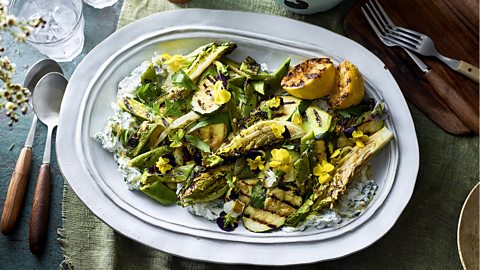Marcus Wareing: From celebrity chef to novice gardener
The Michelin-starred chef has taken time out from his duties as restaurateur and MasterChef judge to create his very own kitchen garden. You can watch it all unfold in the new BBC Two series: Marcus Wareing’s Tales from a Kitchen Garden.

Despite being on the receiving end of many accolades as a chef, Marcus has been desperate to turn his hand to another skill: growing his own fruit and veg. Never one to lack ambition, Marcus took on a 65-acre smallholding four years ago and started planning what to grow throughout lockdown.
It all started with a bunch of daffodils
“You know the daffodil was the one flower I used to stare at in my London garden. It came up at the beginning of the pandemic … I remember planting the bulbs the year before and I thought, 'Oh, I can't wait for them to come up’. Every time I look at a daffodil now, it just reminds me of Covid. It's really weird.”
Looking out at the daffodils Marcus dreamed of his Sussex smallholding. “All I could think about was my garden. It was what I was missing.”
In the 10-part series, Marcus Wareing's Tales From A Kitchen Garden which begins on February 28, at 6.30pm on BBC Two, Marcus travels the country to meet with farmers who give him key advice on what he could grow and farm, and then back home, he implements the tips, alongside his trusted ‘Gardener Anatoli’.
Marcus’s passion as a chef was as important in deciding what to produce as the lay of the land.
“I think it's the fresh flavours you get in a greenhouse: picking a tomato, a bunch of basil, and then an onion out of the ground, a lettuce out of the garden and making up a fantastic salad. Or the beetroot that my wife picks and pickles, or the celeriac that I make into a lovely celeriac soup with some cabbage,” he muses, before adding: “The thought process of the garden chain changes the way you think and cook and the way you eat food as well. And I've never had that experience before.”
Grow what you like to eat

In one episode, we see Marcus plan his orchard around one of his favourite desserts: the tarte tatin. “It's been one of those desserts I’ve always made… It looks stunning and it's got a different type of flavour,” he explains. “It's not easy to make though,” he adds. “You need the right apple, so I've decided to plant [russet] apple trees for the future so that when I eventually retire down there, I've got my own apples, for my own tarte tatin.”
Related articles
Marcus’s tips for beginner gardeners

1. Don’t over complicate things
“I think one of the first things everyone should grow, and they're very easy to grow, is herbs. Get hardy herbs, like rosemary, thyme, parsley, bay. If you get them in then they last. Mint is also simple and then you can make mint tea and put it into pesto.” These can be bought fairly cheaply at garden centres and transplanted into pots of good peat-free compost. Keep them watered and feed them with an all-purpose fertiliser a few times a year. Most herbs need a sunny spot.
Easy perennial herbs
- Mint
- Chives
- Rosemary
- Sage
- Bay
- Thyme
- Parsley
- Lovage
- Marjoram
2. Once you’ve got your herbs, start introducing easy veg in the space you’ve got
“Slowly but surely start to introduce other veg. It’s much easier to grow onions, celeriac and beetroot than it is to grow lettuces and asparagus. You've got to grow into it.”
“If you've got a window box, put some herbs in it and if you've got a bit of a garden, put some wooden sections in and just add some fresh compost in, this will bring some energy back into the soil. Then plant in it, cover it, nurture it, look after it and trust me it will taste so much better, than what you can buy from any supermarket.”
Vegetables for small spaces
- Tomatoes in pots on a sunny sheltered patio, or tumbling varieties on a windowsill
- Chilli peppers grow indoors on a sunny windowsill, but sow early for a good crop
- Beans or peas will grow up a garden wall on bamboo canes
- Mixed leaves for salads in a pot or windowsill
- Grow potatoes in a stack of three tires or a tall growbag
- Spring onions will grow in pots, Welsh onions can be cut and will come again
- Baby beetroots and carrots will grow in pots

3. Think about what will give you the biggest yield…
“I'm always quite surprised at how tomato plants just don't stop giving. Last year we had the whole greenhouse just full of tomatoes along the sides and cucumbers at the back. And Gardener Anatoli planted what I thought was small amounts of basil, but my goodness as it started to grow. You cut it, you eat it, you keep coming back and it just keeps growing and doesn't stop giving.
The size of your crop will depend on the circumstances of your own garden. A sunny sheltered spot that is easy to reach for watering will generally produce a good crop, but weather, pests and disease can all take their toll. Getting to know your own gardening space takes time. A big yield is great if you have friends or family to share with, but too many plants can become a burden if you don’t really like to eat them.
Big croppers
- Courgettes
- Runner beans
- Redcurrants
- Raspberries
4. But not all at the same time
If you have space to grow a lot, plan for plants that ripen and produce over a long period. “If you grow loads of cabbages or salad, it all comes to life at the same time,” says Marcus. A polytunnel, greenhouse – even a small one – helps to extend the season: “…because the sun is shining through and the leaves blocking certain things ripening you have one little batch of tomatoes which is ripe, and you've got some that are still yellow or some that are green. So it's forever evolving …”
Consider growing plants that will keep producing into the winter. “I grew winter lettuce which was great. So in one of the shows, there's a couple of varieties of lettuce that are hardy. As it gets a bit colder you put a plastic cover on. It creates its own little thermal energy and just keeps the warm and the moisture in and through the winter. Then, you've got salads in the winter!”
Autumn/winter croppers
- Kale
- Leeks
- Chicory
- Parsnips
- Swede
- Celeriac
5. Think about who else might want to eat your produce
Slugs and snails are the downside of a climate that’s green and lush. If your garden is beset by slugs, it’s better to find plant varieties that they don’t eat rather than overusing pellets that can harm other wildlife. Young plants are often the most vulnerable and need some protection until they are more mature and can survive a little nibbling.
The old saying goes, 'the best pest control is the gardener’s shadow'. Regularly checking your plants means you can stop any damage before it destroys your plants.
Marcus had to put special precautions in to stop rabbits ruining his efforts. “As long as [crops] are in a raised bed and you surround them with netting that helps to stop the rabbits.” We can imagine some of the other ways Marcus has of putting a stop to the rabbits!
Published February 2022